Suppose it’s 2 AM, your child spikes a fever at midnight. The nearest clinic is miles away, and panic starts to settle in. However, with one tap on a smartphone, you can connect with a pediatrician, get real-time advice, and even schedule a home visit. All issues seem to get solved, all thanks to a healthcare app. Today, it’s a new era of healthcare.
Apps like Practo have completely changed what used to be long waiting hours and paper-based processes into on-demand, digital-first healthcare experiences. Whether virtual consultations, instant prescriptions, or AI-powered symptom checkers, the power to access medical care is now available within a few clicks. From small to big, business owners are paying attention to building a feature-rich healthcare app like Practo.
According to the latest reports by Grand View Research, the global preventive healthcare technologies and services market size is expected to grow at a CAGR of 11.8% between 2023 and 2030. This increasing demand is mainly fueled by tech-savvy users, overwhelmed hospital systems, and the global shift toward digital wellness. However, only replicating the solution, like building a Practo-like app, is not enough. You need to build trust, ensure compliance, integrate advanced features, and scale your app across patient-doctor ecosystems to have a competitive edge.
So, the question is, how do you develop a healthcare app like Practo that users not only download but depend on? If you are a business owner or planning to enter the healthcare sector, this blog will help you explore the full roadmap, from strategy to scalability, that will shape your own smart, future-ready healthcare app. So, let’s dive into it :
Table of Contents
Understanding Practo’s Success Business Model
To truly develop a scalable & feature-loaded healthcare app like Practo, you need to understand the strategic foundation behind its success. Practo isn’t just a doctor app, it’s a multi-sided ecosystem. The app works like magic by connecting patients, doctors, clinics, pharmacies, and labs, all under one seamless digital roof. Initially, the app was built as a doctor discovery platform. After that, it evolved into a full-stack healthcare solution. The app gained popularity by offering online consultations, medicine delivery, diagnostic bookings, and digital health records. The app was built to provide convenience, trust & real-time access to patients. These three major pillars helped them to drive user retention and long-term growth.
On the other side, Practo empowers healthcare providers through the Practo Ray SaaS model, which is a practice management tool offering appointment scheduling, EMR handling, billing, and analytics. The app monetizes through a combination of freemium subscriptions, B2B SaaS offerings, and service commissions. Therefore, making it both scalable and profitable. Practo’s success secret lies in blending user-centric design, healthcare compliance, and a business model that delivers value to every stakeholder in the ecosystem. Therefore, the app is a benchmark for every aspiring healthcare app entrepreneur.
Must-Have Features & Functionalities To Build An App Like Practo
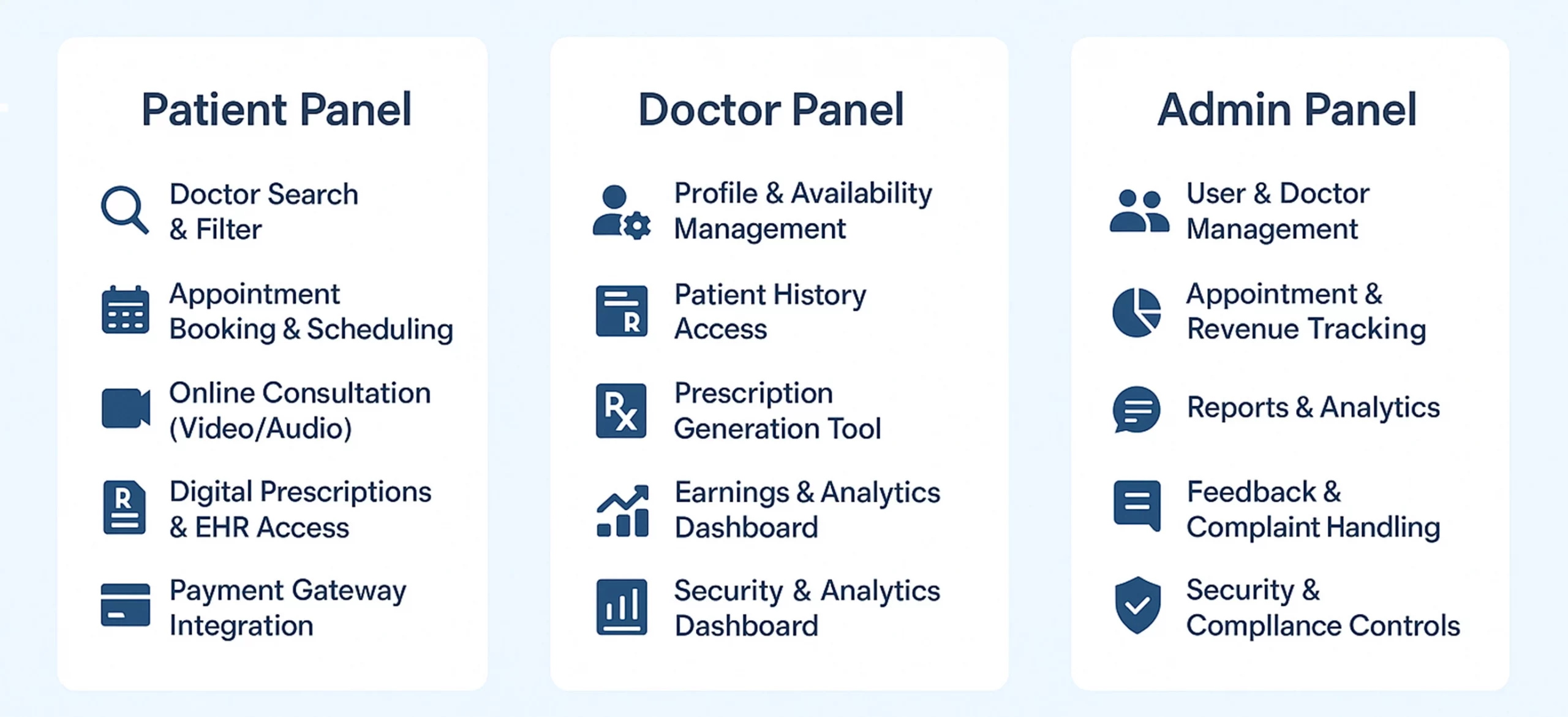
Patient Panel – Top 5 Features
1. Doctor Search & Filter
Patients should easily find the right specialist using advanced filters based on location, medical expertise, patient ratings, and availability. This ensures a personalized and time-efficient experience for patients who are looking for trusted professionals.
2. Appointment Booking & Scheduling
Make sure that patients or users can seamlessly book in-clinic visits or virtual consultations through an intuitive, real-time calendar interface. Users should get instant confirmation and reminders.
3. Online Consultation (Video/Audio)
Another thing to keep in mind is that users should easily connect with doctors from anywhere using secure video or audio calls. This will eliminate the need for in-person visits. This feature offers convenience and immediate care, especially in critical or remote situations.
4. Digital Prescriptions & EHR Access
Access e-prescriptions and complete electronic health records anytime, stored safely in the app. Patients can track their medical history and share it with healthcare providers instantly when needed.
5. Payment Gateway Integration
Make fast, secure, and flexible payments through multiple options like UPI, cards, wallets, or net banking. This ensures a smooth transaction experience post-consultation without leaving the app.
Doctor Panel – Top 5 Features
1. Profile & Availability Management
For doctors or medical professionals, you can set consultation hours, update profile information, and manage service offerings in real-time. This will help them to maintain an up-to-date digital presence and improve patient trust and discoverability.
2. Appointment Management
With this feature in your instant in-app, doctors can accept, reschedule, or decline appointments. It will streamline the workflow and reduce the chances of missed or overlapping consultations. Businesses can also invest in appointment scheduling software to manage consultations & more.
3. Patient History Access
Make sure doctors can easily view detailed medical records, previous prescriptions, and consultation notes. By integrating such features, it allows for better diagnosis and continuity of care with a complete patient background.
4. Prescription Generation Tool
This is also a crucial feature, so that doctors can quickly create, edit, and digitally share prescriptions during or after consultations. Having this feature in the app reduces paperwork and enhances the efficiency of both online and in-clinic practices.
5. Earnings & Analytics Dashboard
There should be a proper analytics dashboard to monitor income streams, appointment stats, and patient engagement through visual dashboards. This empowers medical professionals to analyze performance trends and optimize their consultation time.
Admin Panel – Top 5 Features
1. User & Doctor Management
Control registrations, verifications, and access for both users and healthcare providers. This helps maintain a trusted network of authenticated users and licensed professionals.
2. Appointment & Revenue Tracking
If you integrate this feature, it will help in monitoring all appointment bookings and revenue flows in real time. Moreover, admins can optimize operations and ensure transparent financial management.
3. Reports & Analytics
Get comprehensive & useful insights into platform usage, earnings, and user behavior. These insights help in making data-backed decisions for performance improvements.
4. Feedback & Complaint Handling
You can also integrate such features to manage user feedback and complaints from a centralized dashboard. This feature boosts user satisfaction by ensuring timely issue resolution.
5. Security & Compliance Controls
Always ensure data protection through HIPAA/GDPR adherence and encryption protocols. It builds user trust and meets legal and ethical standards in the healthcare industry.
Read Also: How To Build A Telemedicine App Like Teladoc Health?
How to Build a Healthcare App Like Practo: A Step-by-Step Development Guide
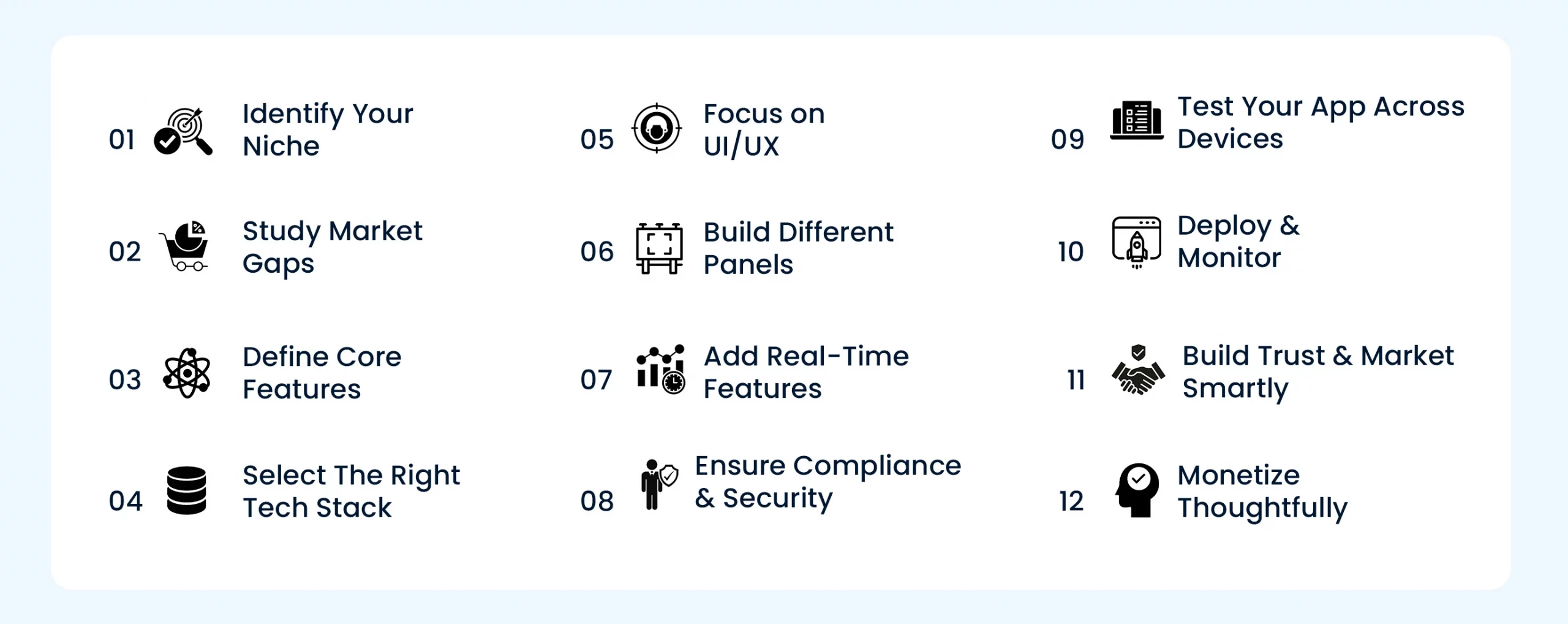
1. Identify Your Niche & Purpose
Start by clearly defining who your app is for. You need to know whether it’s for general health, mental wellness, dental care, or chronic conditions. Apps like Practo succeeded by catering to multiple health verticals. So, you need to decide early what your niche and app purpose are.
2. Study Market Gaps & Patient Needs
Business owners should deep dive into research to understand what existing apps lack. Talk to patients and doctors, explore reviews on top apps, and turn real pain points into opportunities your app can uniquely solve. Also, business owners should be aware of the latest healthcare app development trends to stay ahead in the industry.
3. Define Core Features (MVP First!)
Don’t try to do everything at once. Focus on high-impact features like doctor search, appointment booking, e-prescriptions, and patient records. This MVP approach saves time and money while validating your app idea. A leading telemedicine app development company can help you to seamlessly integrate advanced features and build an MVP version to test your app idea.
4. Choose the Right Tech Stack
Go for scalable technologies like Flutter or React Native for front-end and secure back-end stacks like Node.js with HIPAA/GDPR compliance. Cloud integration is a must for fast, secure access across multiple devices.
5. Design an Intuitive UI/UX
User experience is everything in healthcare. Make sure your app is clean, fast, and super easy to navigate for both patients and doctors. Consider accessibility for senior users as well. So, every user can easily navigate through your app.
6. Build Patient, Doctor & Admin Panels
Segment your app into three main panels: one for patients, one for healthcare providers, and one for the admin. This modular structure keeps functionality focused and smooth for all types of users.
7. Integrate Real-Time Features Smartly
It’s better to integrate advanced features like video consultations, chat, appointment reminders, and e-prescriptions. Also, make sure to make your app secure, and it should provide real-time insights. Use API integration for chat to boost engagement and to have long-term success.
8. Ensure Compliance & Data Security
During the healthcare or telemedicine app development process, you must also prioritize data privacy. So, it is a must to integrate SSL, end-to-end encryption, and ensure compliance with local regulations like HIPAA (USA) or NDHM (India).
9. Test Across Devices & Scenarios
Don’t launch without testing. Run functionality, usability, security, and performance tests on various devices. Real-time tests with doctors and patients help uncover usability friction before the final launch of your app. Feel free to reach out to top healthcare app development companies in USA for testing your app performance.
10. Deploy & Monitor in Phases
Launch your app in controlled stages. This will help you to monitor user activity, crashes, and feedback in real-time. Iterate quickly based on what your early adopters tell you.
11. Market Smartly—Build Trust, Not Hype
Focus your marketing on trust, expertise, and user value. Leverage influencer doctors, patient testimonials, and content marketing around health education to drive organic growth.
12. Monetize Thoughtfully
Adopt monetization strategies like freemium models, subscriptions, featured doctor listings, or lab commissions. Ensure your pricing aligns with the value you provide, as users won’t mind paying for health.
Now, let’s explore the monetization models in depth :
Monetization Models: Turning Care into Capital
Monetization your healthcare app isn’t about profits; it’s about sustaining a platform that delivers continuous value to patients and service providers. If you’re planning to invest in a doctor booking app development like Practo, here are powerful and practical revenue models that turn patient care into sustainable capital:
1. Subscription-Based Model (Freemium to Premium)
Offer basic features for free, like appointment booking or browsing doctors. You can unlock advanced features, such as video consultations, medical history tracking, or priority support, under a monthly or yearly subscription plan. This model builds loyalty among users and predictable revenue.
2. Commission Per Consultation
You can charge a percentage from doctors or clinics for every successful appointment or online consultation booked through the app. This performance-based revenue model ensures you earn as the platform grows, just like Practo’s early monetization model.
3. In-App Advertisement (Ethical & Relevant)
Business owners can carefully integrate health-related ads from pharma companies, diagnostic labs, or wellness brands without harming user trust. Contextual ads (e.g., fitness programs after a weight loss consult) are more engaging and less intrusive.
4. Featured Listings for Doctors & Clinics
Let healthcare providers pay to be listed at the top of search results or in special recommendation carousels. This boosts their visibility and gives you a steady advertising income, especially useful in competitive metro markets.
5. E-Commerce Integration
You can integrate an online pharmacy or tie up with diagnostic labs and earn a commission for every medicine sold or lab test booked. This adds convenience for patients and unlocks an entirely new revenue stream for your app.
Future of Healthcare Apps: Where You Can Outperform Practo
The healthcare app ecosystem is evolving at a rapid pace. Top telemedicine apps like Practo have already set a high benchmark, but it’s far from the final frontier. Emerging technologies like IoT in healthcare app development, AI-driven diagnostics, and hyper-personalized care are new opportunities through which startups & businesses can thrive in the competitive market. Therefore, if you want to outperform Practo, you can offer niche features such as real-time wearable integration, multilingual voice assistants for remote patients, or AI-powered symptom checkers with higher accuracy. Apart from this, you can also offer a multichannel experience across teleconsultation, e-prescriptions, and at-home care services to enhance user retention. As the healthcare market is shifting more towards personalized medicine, the key to leading the industry lies in innovation, agility, and deep user understanding.
Read Also: 8 Future-Proof Healthcare App Ideas for Startups & Entrepreneurs
Conclusion
In today’s digital-first world, developing a healthcare app like Practo is a strategic necessity. From carefully understanding the success of Practo’s business model to mapping out essential patient, doctor, and admin panel features, the development process involves several crucial steps. You need to plan, make an intuitive design, and have strong technical execution to have an edge over your competitors.
Apart from this, you also need to integrate emerging technologies, offer next-gen user experiences, and adopt smarter monetization models to succeed. However, you can partner with a globally recognized healthcare app development company to build a feature-rich, user-friendly app more critical than ever.
So, whether you’re an entrepreneur, a startup founder, or a healthcare provider, it’s the right time to turn your digital healthcare vision into reality. With the right team and tech approach, your app could be the next big breakthrough in the healthcare industry.
FAQ’s
1. How much does it cost to develop a healthcare app like Practo?
The cost to develop a healthcare app like Practo typically ranges from $30,000 to $120,000+. However, the telemedicine app development cost depends on several factors such as features, platform (iOS/Android), tech stack, and development team location.
2. What makes Practo a successful healthcare app?
Practo’s success lies in its all-in-one solution. The app focuses on connecting users with verified doctors, offering online consultation, and ensuring seamless scheduling with real-time updates.
3. How long does it take to build a healthcare app?
Developing a robust & feature-rich healthcare app like Practo usually takes upto 6 months or more. It depends on the complexity, number of modules, and whether you build an MVP first or a full-scale app.
4. Which technology stack is used for healthcare app development?
Popular tech stacks include React Native or Flutter for mobile apps, Node.js or Django for backend, and Firebase or AWS for cloud integration and real-time database management.
5. Why choose a mobile healthcare app development company?
Partnering with a top-notch healthcare app development company ensures compliance, high-quality user experience, secure data handling, and faster time-to-market.


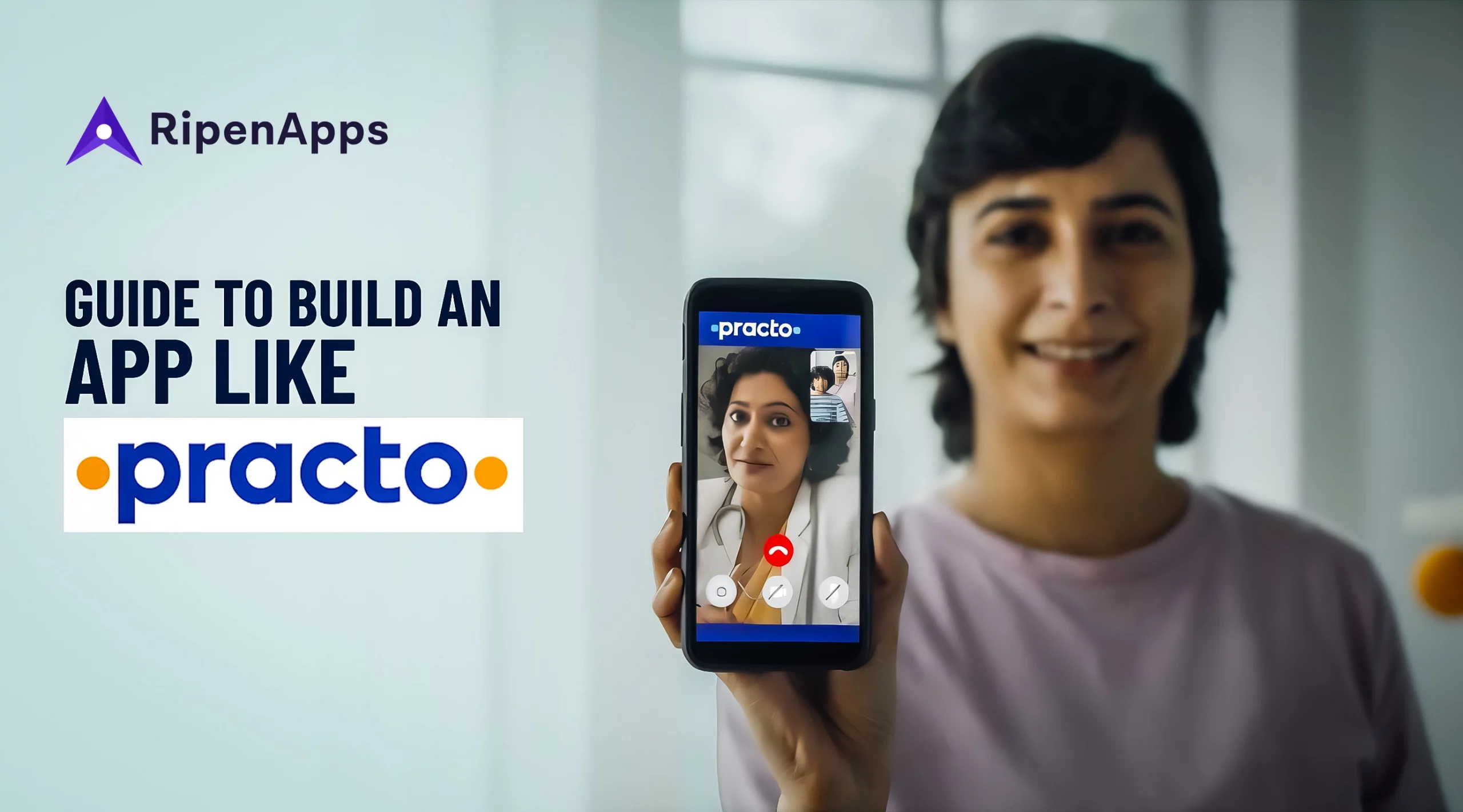




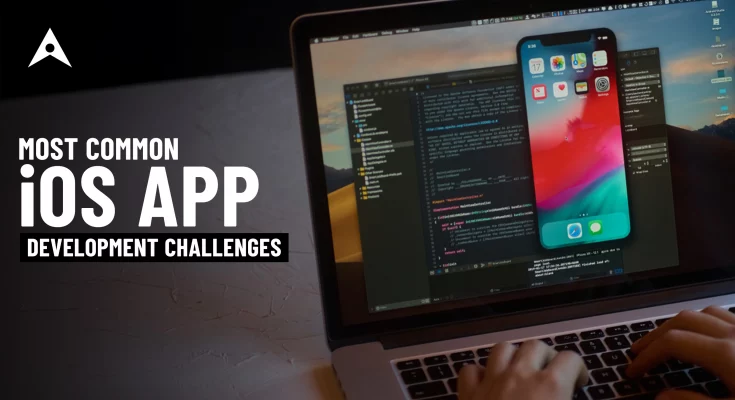
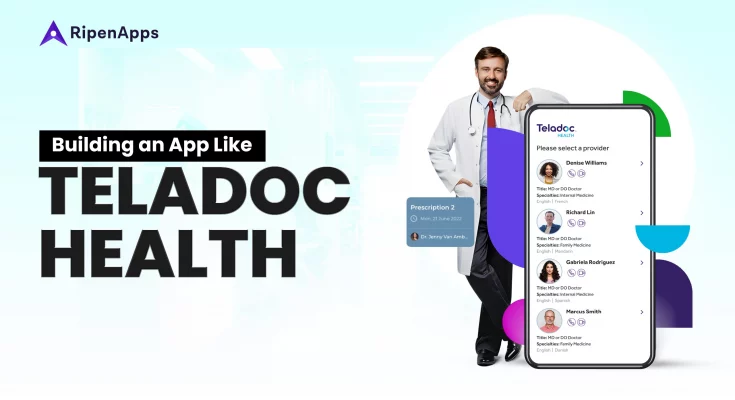
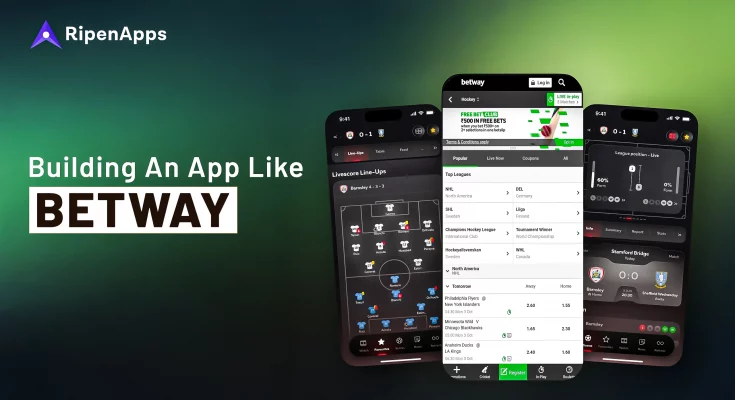
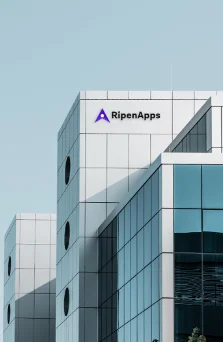
 India
India USA
USA Australia
Australia Canada
Canada UK
UK UAE
UAE
